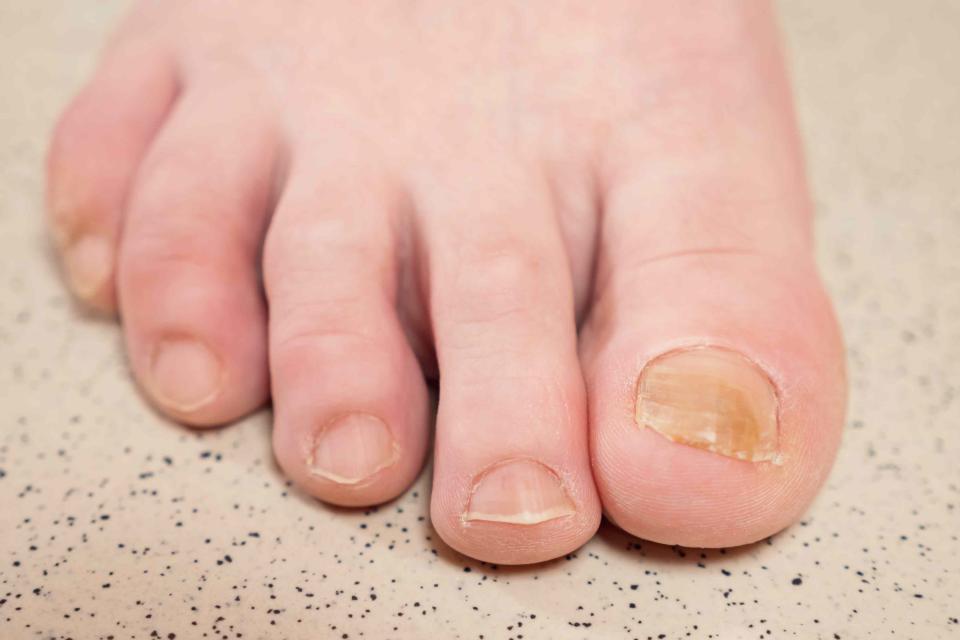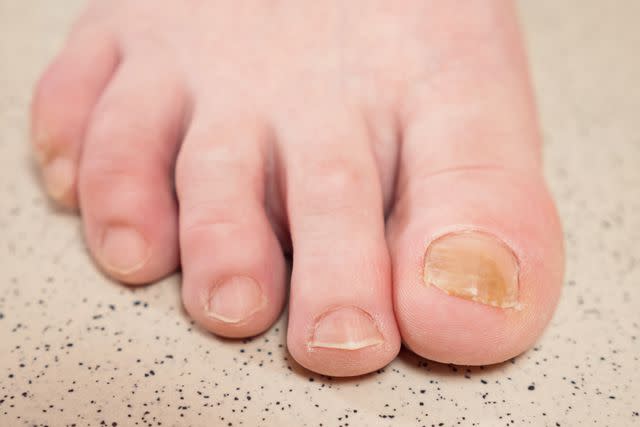Yellow Toenails
Usually Caused by a Fungus but also Medications or a Rare Disease

LENblR / Getty Images
Small changes to your toenails might seem harmless at first or even go unnoticed. But yellow toenails aren’t something to be ignored. Yellow nails, known medically as xanthonychia, are most often caused by a fungal infection called onychomycosis that requires treatment.
They can also be a sign of other, more serious causes, including yellow nail syndrome, a condition that is associated with lung disease and lymphedema.
Continue reading to learn more about yellow toenails, including what yellow toenails indicate, the symptoms associated with them, and how to get rid of yellow toenails.

LENblR / Getty Images
Symptoms of Yellow Toenails
The primary symptom of yellow toenails is changes to the color of the nails on your feet. The nails may appear yellow or yellow-brownish. In addition, you may notice the following toenail fungus symptoms:
Nails that grow thicker than normal
Brittle nails
Nail lifting off the bed
Nails with white spots
Misshapen nails
A foul smell from your feet
Pain
If your yellow toenails are caused by yellow nail syndrome, which is very rare, you’ll likely have symptoms elsewhere in your body, including changes to your fingernails, swelling in the legs, or chronic cough. That’s because, despite its name, yellow nail syndrome also affects the respiratory and lymphatic systems.
Causes of Yellow Toenails
Yellow toenails can be caused by:
Fungal toenail infection, called onychomycosis
Medication complications
Staining from nail polish
Yellow nail syndrome
Fungal Infection
A fungal infection is by far the most likely cause. Onychomycosis affects about 14% of people in the United States. These infections become more common with age. You’re also more likely to have a fungal toenail infection if you have:
A fungal foot infection like athlete’s foot
Injury to the foot or nail
What Medications Can Cause Yellow Toenails
Yellow toenails can be the side effect of medications. In this case, you’ll likely notice yellowing of your fingernails in addition to your toenails. The medications that can cause yellow nails include many antibiotics, as well as other medicines. They are:
Tetracyclines, a class of antibiotics used to treat acne and bacterial infections
Quinolones, broad-spectrum antibiotics (effective against many types of organisms)
Clofazimine, an antibiotic used to treat leprosy
Combivir (lamivudine/zidovudine), used to treat human immunodeficiency virus (HIV)
Psoralens, derived from plants and used to treat skin conditions
Retinoids, a class of vitamin A compounds, often used as an acne medication
Cytotoxic drugs, a type of chemotherapy
Yellow Nail Syndrome
Yellow nail syndrome is a condition that affects the nails, upper respiratory tract and lymphatic system. Symptoms include cough, swelling and yellowing to the fingernails or toenails. This condition is very rare, affecting about one in a million people. It’s much more likely a fungal infection or medications cause your yellow toenails.
How to Treat Yellow Toenails
In most cases treating yellow toenails involves treating a fungal infection. The first line of treatment is usually oral medication.
Oral antifungals include:
Diflucan (fluconazole)
Fulvicin (griseofulvin)
Sporanox (itraconazole)
Lamisil (terbinafine)
Antifungal creams include:
Curanail (amorolfine)
Penlac (ciclopirox)
Jublia (efinaconazole)
Kerydin (tavaborole)
Rarely, a yellow toenail will need to be removed, either with chemicals or by surgery. This is only done as a last resort, if the infection doesn't respond to treatment.
Are There Tests to Diagnose the Cause of Yellow Toenails?
Usually, a healthcare provider can diagnose yellow toenails by looking at your feet. However, if they suspect a fungal infection but need proof, they may send a sample of your toenail to be analyzed in a lab. That can help them identify what is or isn’t causing your yellow toenails.
If a fungal infection isn’t to blame, healthcare providers will ask about your medications. If one of them may be causing yellow toenails, you’ll work together to determine whether you should change medicines. Never discontinue medication without talking with your healthcare provider.
Finally, your healthcare provider may ask about other health concerns, including swelling and cough, to rule out rare conditions like yellow nail syndrome.
When to See a Healthcare Provider
You should see a healthcare provider any time you have yellow toenails. Even if they’re only caused by a fungal infection, yellow toenails don’t typically get better on their own. In fact, your symptoms may get worse. A healthcare provider can help you treat the fungal infection or determine what else might be causing your yellow nails.
Summary
Yellow toenails are most often caused by a fungal nail infection. Other symptoms can include thickening nails, white spots, or pain. If you have yellow toenails, you should see a healthcare provider. They can help you determine whether the yellow hue is caused by a fungus, or something else, including medications or yellow nail syndrome, a rare disease. Although yellow toenails may seem minor, try not to delay care, since that can lead to pain and worsening symptoms.

